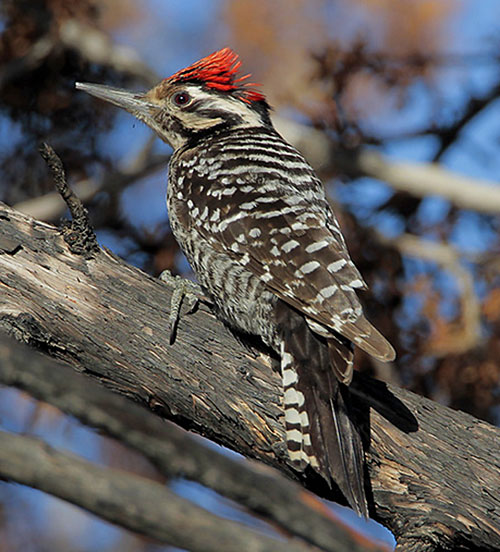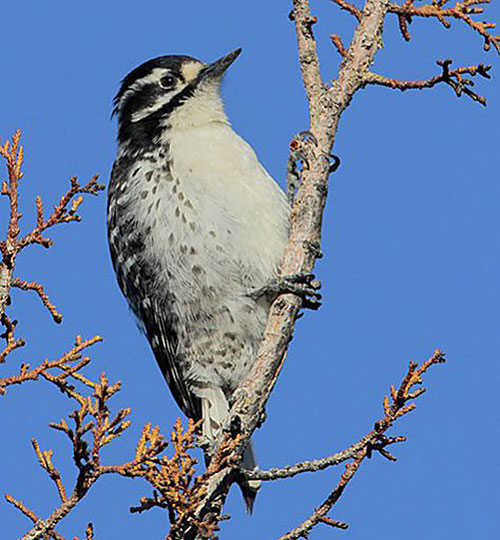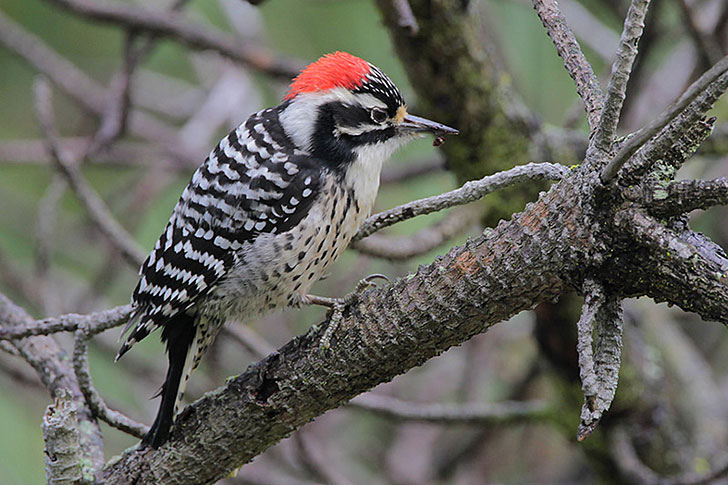Occurring only in California and Baja California, the Nuttall’s Woodpecker is strongly associated with oak woodlands. Nuttall’s Woodpeckers are non-migratory, and maintain year-round territories. Males and females spend no time together in late summer, and most of their time together in early spring.
Male Nuttall’s Woodpeckers do the nest cavity excavation, and a new cavity is created for each breeding season. Relatively few Nuttall’s Woodpeckers have been banded, and almost no banding returns have been recorded, so it is not known how long they live.
On this page
Description of the Nuttall’s Woodpecker
BREEDING MALE
The Nuttall’s Woodpecker has black and white barred upperparts with a solid black area just below the nape, white stripes on a black face, a white throat, and white underparts spotted with black.

Male. Photograph © Greg Lavaty.
Males have a red hind crown.
Female
Females have a black crown.
Seasonal change in appearance
None.
Juvenile
Juveniles resemble adults but have mottled red on the crown and forehead.
Habitat
Nuttall’s Woodpeckers inhabit oak canyons or foothills.
Diet
Nuttall’s Woodpeckers eat insects.

Female. Photograph © Greg Lavaty.
Behavior
Nuttall’s Woodpeckers forage on tree trunks, limbs, and branches.
Range
Nuttall’s Woodpeckers are resident in parts of California and Baja California. The population appears to be stable.
Fun Facts
Besides an often reported and strong association with oaks, relatively little is known about the basic biology of the Nuttall’s Woodpecker.
Nuttall’s Woodpeckers often move by creeping rather than by the hitching movements made by most other woodpeckers when on a trunk.
Vocalizations
Calls include a sharp “pittit”, sometimes followed by a rattle or trill.
Similar Species
- Ladder-backed Woodpeckers have less black in the face, a buffy tinge to the underparts, and lack the solid black area below the nape.
Nesting
The Nuttall’s Woodpecker’s nest is an excavated cavity in a tree or utility pole.
Number: Usually lay 3-4 eggs.
Color: White.
Incubation and fledging:
The young hatch at about 14 days, and leave the nest in about 4 weeks, though continuing to associate with the adults for some time.
Bent Life History of the Nuttall’s Woodpecker
Published by the Smithsonian Institution between the 1920s and the 1950s, the Bent life history series of monographs provide an often colorful description of the birds of North America. Arthur Cleveland Bent was the lead author for the series. The Bent series is a great resource and often includes quotes from early American Ornithologists, including Audubon, Townsend, Wilson, Sutton and many others.
Bent Life History for the Nuttall’s Woodpecker – the common name and sub-species reflect the nomenclature in use at the time the description was written.
DRYOBATES NUTTALLI (Gambel)HABITS
Though closely resembling, superficially, the ladder-backed woodpeckers of the scalaris group, Nuttall’s woodpecker is a very distinct species; the ranges of the two species come together at several points but do not overlap; and the habitats of the two are in different types of environment. The 1931 A. 0. U. Check-List gives the range of nuttalli as “Upper Austral Zone west of the southern Cascade Mountains and the Sierra Nevada from southern Oregon to northwestern Lower California.
W. Leon Dawson (1928) described the haunts of this woodpecker very well, as follows:
Although one who Is forming the acquaintance of the Nuttall Woodpecker soon learns where to look for him, his range is hard to characterize in terms of associations. Upper Sonoran, foothill, oak, live oak, chaparral, deciduous trees bordering narrow stream beds: all these apply to nuttalli well enough, but they are not exhaustive, save for the first, which is all Inclusive. Within Upper Sonoran limits it is, perhaps, easier to tell where he will not be found; thus, not (or only occasionally) in pine timber; not in stands of pure willow (which are given over to D. pubescens turati) not in orchards, nor about cultures of any sort; not, most decidedly, “nesting in giant cactus.” Least of all, is it “seldom found along streams,” as one precocious authority avers. A narrow canyon whose floor harbors sycamores and alders and bay trees, nourished by a purling stream, and whose sides are lined with live oaks which run up Into ceanothus chaparral, is precisely the best place to look for D. nuttalli.
Nesting: Major Ben dire (1895) quotes the following contribution from B. T. Gault:
I bad been out on the bowlder plain [in the San Bernardino Valley several hours, on the morning of April 23, 1883, collecting birds, and spying a clump of elder bushes in the distance, not far from the brook, the thought occurred to me that I might take a rest beneath their shade and at the same time be ready for any bird that put in an appearance. These bushes, or more properly trees, are a great deal larger shrub than our eastern plant, their trunks growing from 4 to S inches through; and if they are not the same species, their umbellate blossoms are strikingly similar, If not identical, to those of our common eastern shrub (Saonbacus canadensis). I had hardly seated myself on an arm of the shrub when my attention was attracted to a hole in the main trunk, directly above my head. At almost the same instant a bird appeared at the opening from within, and dodged back again as soon as she saw me. The movement was executed so quickly that I was unable to tell whether it was a wren or a woodpecker, but concluded that it was the latter. Upon examination of the aperture it seemed to have been lately made. Of course I thought that there would be no trouble in dislodging her, and commenced to rap on the trunk of the shrub with the butt of my gun; but this seemed to have no effect. I then walked back about 50 feet, and taking a stand, waited from ten to fifteen minutes In the hope that she would come out, affording me an opportunity to secure her and thus solve the mystery, but in this maneuver I was also baffled. I then went up to the bush and shouted with all my might, but this did not shake her nervous system in the least, when I finally resorted to my jackknife in order to enlarge the orifice, but from its being such a tedious job, gave It up in disgust. The next morning I took a hatchet along with me, for I desired very much to know what that hole contained. It did not take me very long to cut a place large enough for me to get my hand in, and I was thoroughly surprised to learn that the bird was still on her nest I pulled her out, and she appeared to be stupefied: dead, apparently: but soon revived. Upon further inspection I found that the nest contained eggs. The bird proved to be a female Nuttall’s woodpecker, and the eggs were pretty well advanced in incubation and would have hatched in a few days.
The nest, which was about 5% feet from the ground, was nearly a foot deep and about 5 inches wide. The hole at the entrance to the nest was but a little larger than a silver half dollar. The eggs were six in number.
Mr. Dawson’s (1923) remarks on the nesting of this woodpecker are rather cryptic, but I infer from them that it nests in willows, alders, elders, cottonwoods, sycamores, live oaks, and other oaks and at heights varying from 2½ to 60 feet above ground. The only nest of this species that I have seen was shown to me by A. M. Ingersoil, while collecting with him and James B. Dixon, in San Diego County, Calif., on April 9, 1929; the nest, which the birds had not quite finished excavating, was about 30 feet from the ground in a leaning, dead cottonwood tree (p1. 11). A set of four eggs in my collection was taken by Henry W. Carriger, on April 23, 1897, in Sonoma County, Calif.; the nest was in a dead limb of a large laurel along a creek; he had taken a set of six eggs from the same tree the previous year.
Eggs: Nuttall’s woodpecker lays three to six eggs, must commonly four and often five. These are ovate, or rarely short-ovate or elliptical-ovate. The color is dull creamy white or pure white, and sometimes rather glossy. The measurements of 47 eggs average 21.75 by 16.27 millimeters; the eggs showing the four extremes measure 25.0 by 16.0, 23.3 by 17.0, 19.30 by 15.75, and 19.7 by 14.6 millimeters.
Young: The period of incubation is said to be about 14 days, and be shared by both sexes. Mr. Dawson (1923) says:
The male Nuttall not only takes a lively interest in all matters connected with the nesting, but it is believed that he monopolizes the task of excavation. Certainly he takes his turn at Incubating, and he is invariably, In my apedence, the more valiant of the two in defense of young. The female, however, is probably the closer sitter, as there are several instances in which she has submitted to the hand rather than forsake her trust. * * * When the chicks are astir the father is fairly beside himself with joy and apprehension. In fact, if you ever require a symbol of doting solicitude, picture a male Nuttall woodpecker thrusting his head Into a dark hole to make sure that nothing has spilled out of it since his last inspection: which occurred exactly three seconds ago.
Plumages: The young are hatched naked, as with other woodpeckers, but the juvenal plumage is acquired before the young leave the nest. The young male, in juvenal plumage, has the forehead, occiput, and nape uniform dull black, leaving only the crown scarlet, spotted or speckled with white dots; the black bars on the back are dull black and the white bars are grayish white, instead of clear black and pure white, as in the adult; these bars are also less clearly defined than in the adult; the under parts are yellowish white, spotted on the sides and flanks less distinctly than in the adult, and with pale dusky, instead of clear black; the wings and tail are as in the adult.
The young female is similar to the young male, except that the red of the crown is more restricted and the forehead is streaked with white. This plumage is, apparently, worn all through the first summer; I have seen young birds in this plumage as late as August 30. Probably early in fall a postjuvenal molt produces a plumage that is practically adult. I have been unable to learn anything about the molts of adults. Ridgway (1914) says that spring males have the “white streaks on forehead and crown much reduced in size, sometimes obsolete, and red nuchal area more restricted, through wearing off of red tips of feathers.” The white streaks on the crown of the adult female also wear away almost entirely during winter, leaving the crown clear black.
Food: The food of Nuttall’s woodpecker is very similar to that of the downy and other small woodpeckers. Prof. F. E. L. Beal (1911) summarizes it by saying: “In its animal food the Nuttall woodpecker is beyond criticism. Practically all of the insects eaten are either pests or of no positive benefit. While some fruit is eaten, it consists largely, and perhaps entirely, of wild varieties. Probably the worst that can be said of the bird is that it helps in the distribution of poison-oak seeds.”
Among the insect food, the most prominent items seem to be the larvae of the very harmful wood-boring beetles Cerambycidae and Elateridae; other beetles are eaten largely, as well as ants and other Hymenoptera, scales, plant lice and other bugs, weevils, caterpillars, spiders, flies, and millipeds. Prof. Beal (1911) says: “Two stomachs contained each between 30 and 40 box-elder bugs (Leptocoris trivittatus). These insects have a way of becoming very abundant at times and making a nuisance of themselves by invading buildings in search of winter quarters.”
The vegetable food consists mainly of wild fruits, such as blackberries, elderberries, and th5 seeds of poison-oaks; a few acorns and some grain are occasionally eaten. Grinnell, Dixon, and Linsdale (1.930) write: “Trees that this woodpecker foraged over were sycamore, cotton, valley oak, blue oak (most frequently), digger pine, yellow pine (rarely), and orchard trees. On June 3, 1926, one was seen feeding on cherries in an orchard near Manton.”
Behavior: Florence M. Bailey (1902) says of this little woodpecker:
It has a nuthatch-like way of flying up to light on the underside of a limb, and when hanging upside down turns Itself around with as much ease as a fly on a ceiling. * * *
He is a sturdy little fellow, and in flight will sometimes rise high In air and fly long and steadily, dipping only slightly over the brush. He has the full strength of his convictions and will drive a big flicker from a sycamore and then stretch up on a branch and can out triumphantly. Two Nuttalls trying to decide whether to fight are an amusing sight They shake their feathers and scold and dance about as if they were aching to fly at each other, but couldn’t quite make up their minds to so grave a matter.
Voice: The same writer says of the voice of Nuttall’s woodpecker: “At times the small Nuttall waxes excited, and shakes his wings as he gives his thin, rattling call. All his notes are thin, and his quee-quee-quce-quee’p has a sharp quality. His chit’ tah is a diminutive of the ja’ cob of the California woodpecker.”
Ralph Hoflmann (1927) says: “One cannot remain long near a grove of live oaks in the foothills of California without hearing from some tree a hoarse ringing call prrip, often lengthened to a rattling prrrrrrt. It has the exclamatory quality of the Hairy Woodpecker’s, but is less clear and metallic, with more burr. * * * Like the other woodpeckers the Nuttall, particularly in spring, drums on resonant timber or telephone poles; it also gives at that season a rapid, squealing quee quee quec quee.”
Mr. Dawson (1923) says that this woodpecker “always has a grouch on, and you are sure to be challenged as you pass, by repetition of his double notes of distrust, ticket, ticket: ticket it.”
Field marks: Nuttall’s woodpecker closely resembles the cactus woodpecker, and where the ranges of the two species come together, in southeastern California, there is a chance for confusion; but their ranges barely touch each other, and fortunately the habitats of the two species are quite different and mainly well separated. Nuttall’s is somewhat lighter colored on the under parts, and the black bands on the back are slightly wider than in the cactus woodpecker; but the best distinguishing mark, if the observer is near enough to see it, is the black forehead and front of the crown, which in the male cactus woodpecker is spotted with white and red. It is only slightly larger than the downy woodpeckers but can be readily distinguished from that species by the conspicuous, transverse barring of black and white on the back, instead of the broad, white, longitudinal band of the downies; there are also more white spots in the wings than in the western races of the downy.
DISTRIBUTION
Range: Southwestern Oregon, California, and northern Baja California; nonmigratory.
The range of Nuttall’s woodpecker extends north to southwestern Oregon (probably Ashland); and northern California (Weed and Lassen Peak). East to California (Lassen Peak, Oroville, probably Florence Lake, Owens Lake, and Redlands); and Baja California (San Rafael and San Domingo). South to northern Baja California (San Domingo and Ensenada). West to northwestern Baja California (Ensenada); western California (San Diego, San Onofre, Santa Barbara, Morro, Monterey, and East Park); and southwestern Oregon (probably Ashland).
Egg dates: California: 82 records, March 25 to June 14; 41 records, April 21 to May 6, indicating the height of the season.


